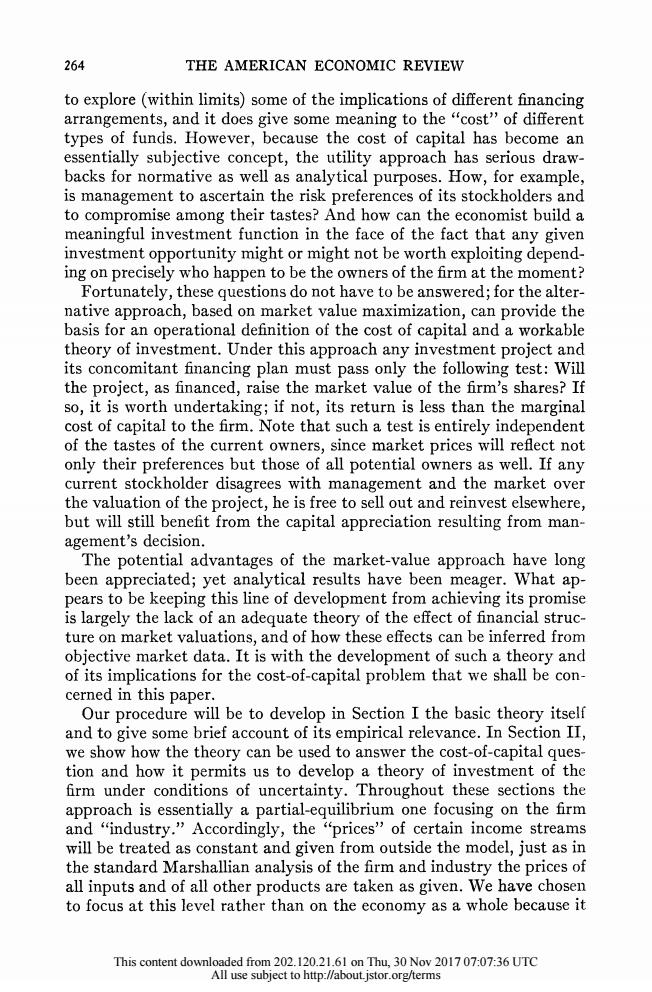正在加载图片...

264 THE AMERICAN ECONOMIC REVIEW to explore(within limits)some of the implications of different financing arrangements,and it does give some meaning to the"cost"of different types of funds.However,because the cost of capital has become an essentially subjective concept,the utility approach has serious draw- backs for normative as well as analytical purposes.How,for example, is management to ascertain the risk preferences of its stockholders and to compromise among their tastes?And how can the economist build a meaningful investment function in the face of the fact that any given investment opportunity might or might not be worth exploiting depend- ing on precisely who happen to be the owners of the firm at the moment? Fortunately,these questions do not have to be answered;for the alter- native approach,based on market value maximization,can provide the basis for an operational definition of the cost of capital and a workable theory of investment.Under this approach any investment project and its concomitant financing plan must pass only the following test:Will the project,as financed,raise the market value of the firm's shares?If so,it is worth undertaking;if not,its return is less than the marginal cost of capital to the firm.Note that such a test is entirely independent of the tastes of the current owners,since market prices will reflect not only their preferences but those of all potential owners as well.If any current stockholder disagrees with management and the market over the valuation of the project,he is free to sell out and reinvest elsewhere, but will still benefit from the capital appreciation resulting from man- agement's decision. The potential advantages of the market-value approach have long been appreciated;yet analytical results have been meager.What ap- pears to be keeping this line of development from achieving its promise is largely the lack of an adequate theory of the effect of financial struc- ture on market valuations,and of how these effects can be inferred from objective market data.It is with the development of such a theory and of its implications for the cost-of-capital problem that we shall be con- cerned in this paper. Our procedure will be to develop in Section I the basic theory itself and to give some brief account of its empirical relevance.In Section II, we show how the theory can be used to answer the cost-of-capital ques- tion and how it permits us to develop a theory of investment of the firm under conditions of uncertainty.Throughout these sections the approach is essentially a partial-equilibrium one focusing on the firm and "industry."Accordingly,the "prices"of certain income streams will be treated as constant and given from outside the model,just as in the standard Marshallian analysis of the firm and industry the prices of all inputs and of all other products are taken as given.We have chosen to focus at this level rather than on the economy as a whole because it This content downloaded from 202.120.21.61 on Thu,30 Nov 201707:07:36 UTC All use subject to http://about.jstor.org/terms264 THE AMERICAN ECONOMIC REVIEW to explore (within limits) some of the implications of different financing arrangements, and it does give some meaning to the "cost" of different types of funds. However, because the cost of capital has become an essentially subjective concept, the utility approach has serious draw- backs for normative as well as analytical purposes. How, for example, is management to ascertain the risk preferences of its stockholders and to compromise among their tastes? And how can the economist build a meaningful investment function in the face of the fact that any given investment opportunity might or might not be worth exploiting depend- ing on precisely who happen to be the owners of the firm at the moment? Fortunately, these questions do not have to be answered; for the alter- native approach, based on market value maximization, can provide the basis for an operational definition of the cost of capital and a workable theory of investment. Under this approach any investment project and its concomitant financing plan must pass only the following test: Will the project, as financed, raise the market value of the firm's shares? If so, it is worth undertaking; if not, its return is less than the marginal cost of capital to the firm. Note that such a test is entirely independent of the tastes of the current owners, since market prices will reflect not only their preferences but those of all potential owners as well. If any current stockholder disagrees with management and the market over the valuation of the project, he is free to sell out and reinvest elsewhere, but will still benefit from the capital appreciation resulting from man- agement's decision. The potential advantages of the market-value approach have long been appreciated; yet analytical results have been meager. What ap- pears to be keeping this line of development from achieving its promise is largely the lack of an adequate theory of the effect of financial struc- ture on market valuations, and of how these effects can be inferred from objective market data. It is with the development of such a theory and of its implications for the cost-of-capital problem that we shall be con- cerned in this paper. Our procedure will be to develop in Section I the basic theory itself and to give some brief account of its empirical relevance. In Section II, we show how the theory can be used to answer the cost-of-capital ques- tion and how it permits us to develop a theory of investment of the firm under conditions of uncertainty. Throughout these sections the approach is essentially a partial-equilibrium one focusing on the firm and "industry." Accordingly, the "prices" of certain income streams will be treated as constant and given from outside the model, just as in the standard Marshallian analysis of the firm and industry the prices of all inputs and of all other products are taken as given. We have chosen to focus at this level rather than on the economy as a whole because it This content downloaded from 202.120.21.61 on Thu, 30 Nov 2017 07:07:36 UTC All use subject to http://about.jstor.org/terms